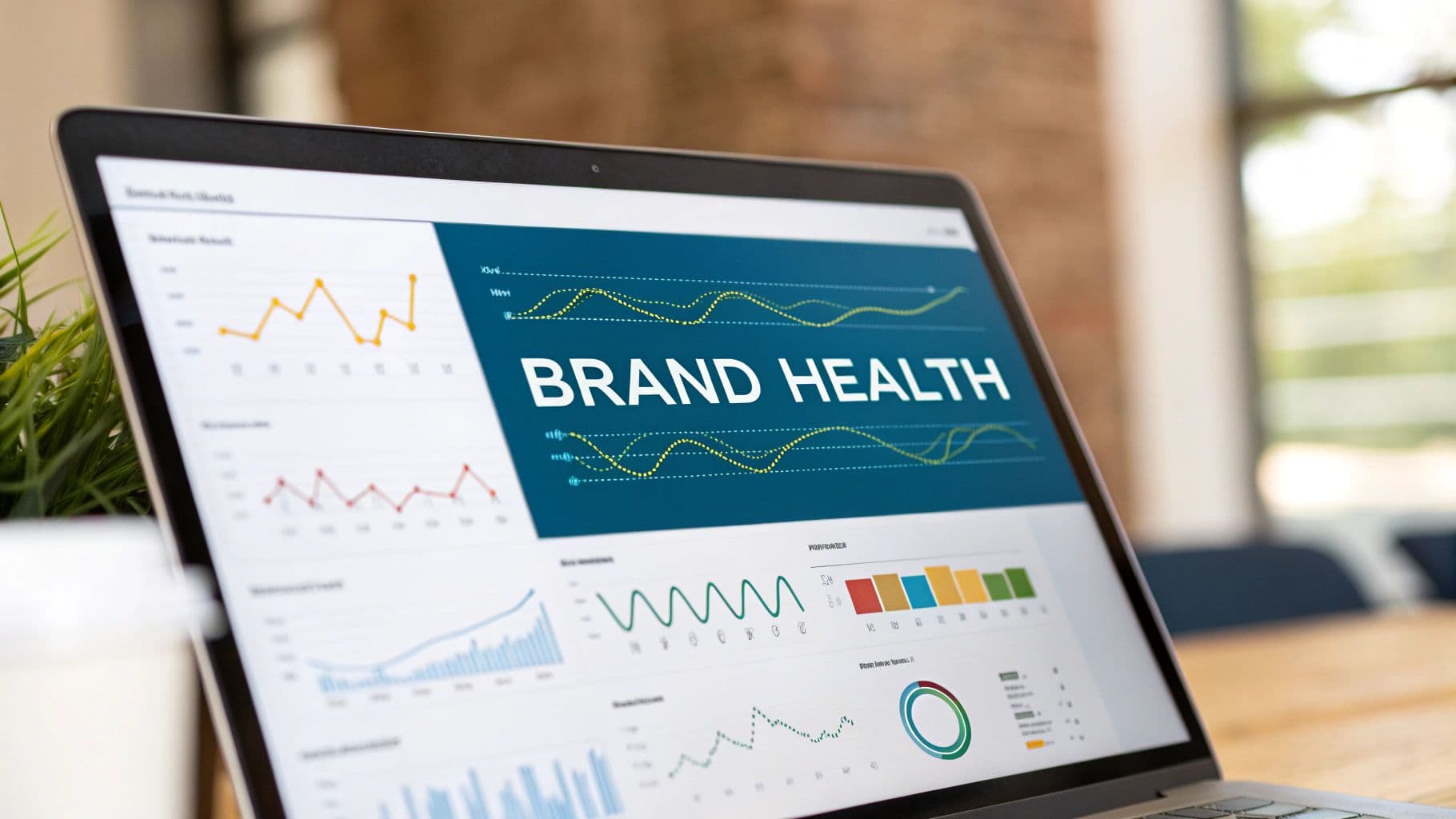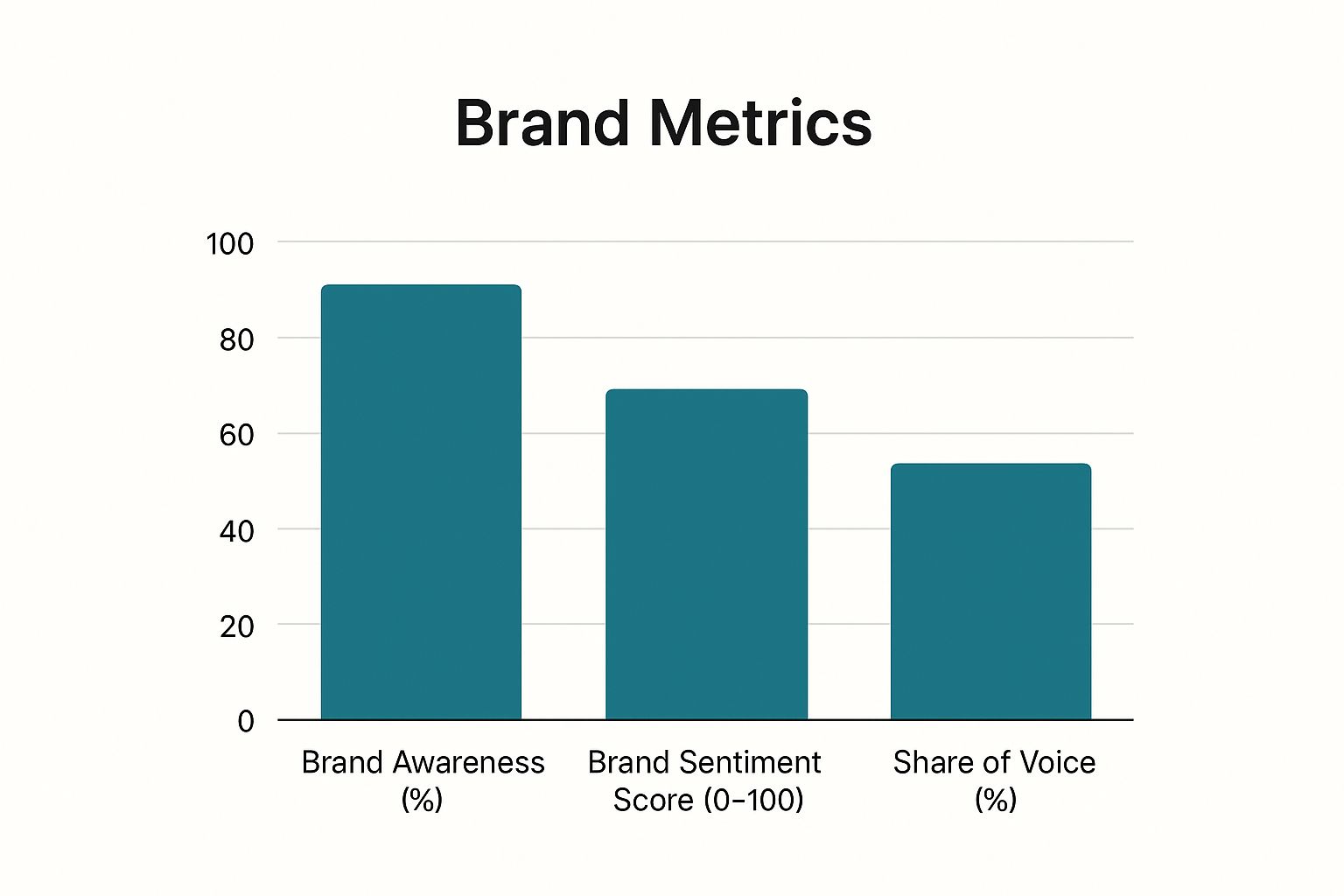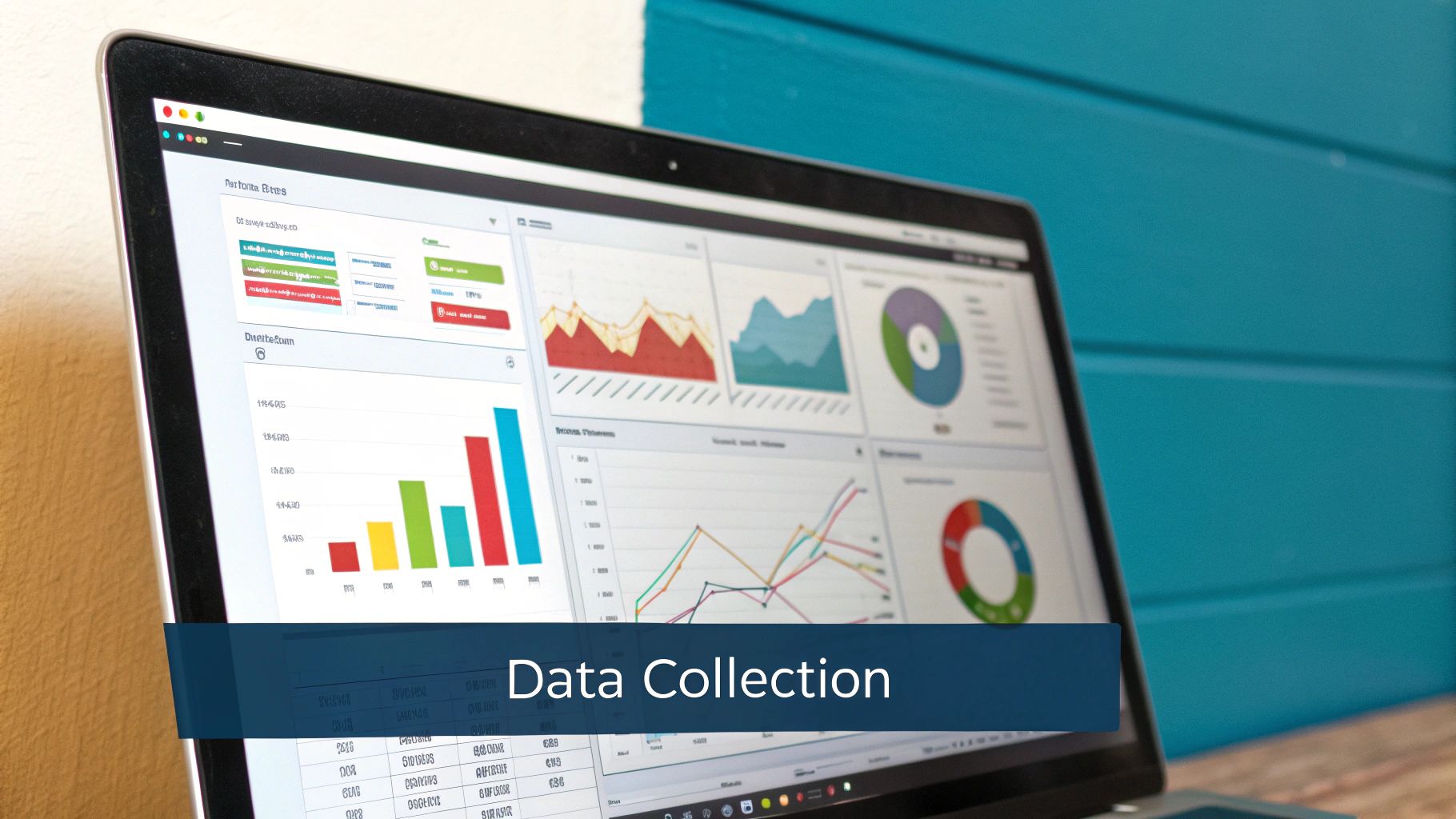
Forget the textbook definitions. Brand health tracking is our EKG for BillyBuzz. It’s how we listen to what customers, the market, and our competitors are saying about us in real-time. This isn't a "big corporation" luxury; for us, it's a survival tool.
What Is Brand Health Tracking Anyway

We think of our brand as a relationship with our audience. And like any relationship, it needs constant check-ins. Hoping for the best is a gamble we can't afford. The alternative is the difference between proactively shaping our story and constantly putting out fires we never saw coming.
This ongoing monitoring is our early-warning system and our strategic roadmap. For a more detailed look at the basics, understanding the importance of online reputation management offers some great foundational context.
A Founder's Early Warning System
Why is this non-negotiable for us? Because perception can turn on a dime. One study found that 54% of customers would walk away from a brand after just one bad experience. If you don't have a system to catch the first whispers of trouble, you're flying blind.
Brand health tracking helps us pick up on subtle shifts before they become crises. It's how we spot small cracks in customer satisfaction or notice a competitor's quiet gains while we still have time to respond.
In essence, brand health tracking is less about marketing metrics and more about market intelligence. It’s how you keep your finger on the pulse of your audience and your industry, ensuring you’re always relevant and resilient.
This isn't just about dodging bullets. It’s also how we uncover opportunities. By listening intently, we pinpoint:
- Unmet Customer Needs: What pain points are people talking about that our product could solve?
- Competitor Weaknesses: Are customers complaining about a rival's service in a way that highlights our strengths?
- Emerging Trends: What new features or topics are suddenly buzzing in our niche?
Beyond Sales and Social Media Likes
Real brand health tracking goes deeper than vanity metrics. We systematically monitor brand awareness, public perception, customer engagement, and overall loyalty. This lets us react swiftly to changes in sentiment and stay ahead of the curve. It’s all about understanding how people truly feel and interact with our brand over the long haul, not just tallying up followers.
Ultimately, this practice gives us an honest, unfiltered look at where we stand. It tells us if our messaging is landing, if our product is delivering, and if our customers genuinely connect with our mission. For any founder, that feedback is gold.
The Metrics We Actually Use to Track Brand Health
Theory is great, but as founders, we live and die by execution. It’s easy to get lost in dozens of potential metrics, so at BillyBuzz, we focus on a core set that gives us the most signal with the least noise. This isn't an abstract list; this is our actual dashboard.
We cut through the vague concepts to zero in on the data that directly informs our decisions. These are the metrics that tell us if our message is landing, if customers are happy, and if we're actually gaining ground on the competition. Think of it as a clear, repeatable framework any founder can use to build their own brand monitoring system.
This chart shows you a snapshot of the exact things we look at: Brand Awareness, Brand Sentiment, and our all-important Share of Voice.

Just a quick glance at data like this tells a story. You can immediately see where the brand is strong and, more importantly, where you need to focus your efforts to grow.
Our Core Brand Health Tracking Metrics
To give you a clearer picture, here’s a breakdown of the specific metrics we track, what they tell us, and why they're so vital when you're in the trenches building a company.
| Metric | What It Measures | Why It's Critical for a Founder |
|---|---|---|
| Share of Voice (SoV) | Your brand's percentage of the total online conversation versus competitors. | It's your competitive pulse check. Are you being heard, or are you being drowned out? |
| Sentiment Analysis | The emotional tone behind brand mentions (positive, negative, or neutral). | This is your early warning system. It tells you how people feel, not just if they're talking. |
| Net Promoter Score (NPS) | Customer loyalty and willingness to recommend your product to others. | It’s a direct measure of product-market fit and a strong predictor of future word-of-mouth growth. |
This isn't just data for data's sake. Each of these metrics answers a fundamental question about the health and trajectory of our business.
Share of Voice (SoV)
Share of Voice is our go-to for competitive intelligence. In simple terms, it measures how much of the conversation in our market we own compared to our rivals. Are people talking about us more or less than them? You can think of it as the digital equivalent of shelf space in a supermarket.
A healthy SoV for a growing startup might hover around 10-15%. If you’re a new challenger brand, even grabbing 5% in a crowded market is a solid start. It tells us if our marketing and PR efforts are actually cutting through the noise. To do this right, you need the right brand awareness measurement tools that can automate this kind of competitive analysis.
Sentiment Analysis
Honestly, this is probably the most critical metric for any founder. Sentiment analysis moves beyond just counting mentions and tells you how people actually feel about you. It automatically categorizes mentions as positive, negative, or neutral, giving you an immediate emotional pulse check on your brand.
We aim for a positive sentiment score of over 70%. A sudden dip is our first red flag that something’s wrong—a product bug, a confusing marketing message, or a customer support meltdown. Getting a handle on this emotional tone is everything. You can see how we visualize this data for quick insights by checking out our deep dive into using sentiment graphs for brand monitoring.
A high volume of mentions means nothing if the sentiment is overwhelmingly negative. Sentiment is the context that gives all other brand health tracking metrics their true meaning.
Net Promoter Score (NPS)
While SoV and Sentiment track the public conversation, Net Promoter Score gets personal and measures customer loyalty. It’s all based on one powerful question: "On a scale of 0-10, how likely are you to recommend our brand to a friend or colleague?" This simple survey gives us a hard number on customer advocacy.
The score is calculated by subtracting the percentage of Detractors (those who score you 0-6) from the percentage of Promoters (those who give a 9 or 10). A "good" NPS score can vary by industry, but anything above 0 is decent, above 20 is favorable, and anything over 50 is excellent. For a SaaS startup like ours, we fight to keep our NPS above 40. It’s a direct indicator of product-market fit and a leading signal for future organic growth.
By combining these three, we get a complete picture:
- SoV: Are we visible in the market?
- Sentiment: Is that visibility a good thing or a bad thing?
- NPS: Are our actual users happy enough to stick their necks out for us?
This trifecta is the foundation of our brand health tracking. It gives us a clear, actionable snapshot of where we stand at any given moment.
Our Playbook for Finding Every Brand Mention

The conversations that can make or break your brand are happening right now. They're buried in niche forums, scattered across Reddit threads, and tucked away in uncategorized blog comments. Truly effective brand health tracking means knowing where to look.
As a founder, you need a scrappy, high-signal system. This is our internal playbook at BillyBuzz.
We don’t just monitor "BillyBuzz". We track key executives, specific product features, and common misspellings like "BillyBuz". You’d be surprised how many valuable conversations you miss from a single typo.
Setting Up Your Listening Posts
Your first move is to establish listening posts where your ideal customers actually hang out. For us, that means a heavy focus on specific online communities and social platforms.
Our Actual Reddit Monitoring Filters:
- /r/SaaS: Ground zero. We look for posts about marketing tools, lead generation, and competitor mentions.
- /r/startups: We monitor for founders asking about early-stage growth hacks and brand monitoring.
- /r/marketing: A great place to find conversations around social listening and engagement strategies.
- /r/growmybusiness: Broader discussions, but often contains gems from small business owners looking for an edge.
The screenshot above from /r/SaaS is what our daily feed looks like. It’s a mix of technical questions, tool recommendations, and strategic discussions—each one a potential opportunity.
Mastering Twitter/X Search Operators
Twitter/X is a firehose of noise. We use advanced search operators to cut through it. You can plug these directly into the search bar or build columns in a tool like TweetDeck (X Pro).
Here are our go-to search strings:
"customer support tool" -BillyBuzz -filter:links: Finds people discussing our category but filters out our own brand and link-only posts. This shows us raw, organic conversation."competitor name" AND (frustrated OR annoyed OR "customer service"): Pinpoints unhappy customers of our competitors."looking for a tool to" (monitor OR track) Reddit lang:en: Identifies active buyers searching for a solution like ours.
These precise queries transform a chaotic feed into a curated list of leads and insights. The key is to think like your customer: search for the problems they’re trying to solve.
Making Google Alerts Actually Work
Google Alerts is a fantastic free tool, but its default settings are too broad. We make it useful with a few critical tweaks.
The secret to a high-signal Google Alert isn't the keyword; it's the combination of specific operators and filters you apply to it. A well-configured alert is the difference between intelligence and information overload.
Here’s our configuration for a high-quality alert:
- Use Exact Match Keywords: We use
"BillyBuzz", notBillyBuzz. We also create separate alerts for things like"Jane Doe" CEO BillyBuzzto track executive mentions. - Filter by Source: We change "Sources" from "Automatic" to "Blogs" or "News" to focus on higher-quality content.
- Set the Right Cadence: We use "As-it-happens" for our main brand name so we can react quickly. For less urgent keywords, a "Once a day" digest is perfect.
By combining targeted Reddit monitoring, precise Twitter/X searches, and optimized Google Alerts, we've built a comprehensive listening engine from the ground up. This framework allows us to catch nearly every relevant conversation about our brand, our competitors, and our market.
For an even more detailed walkthrough, check out our guide on setting up real-time social media alerts. It’s a foundational step in any serious brand health tracking program.
How We Handle Public Feedback
Spotting a mention is step one. What you do next defines your brand. Are you helpful? Defensive? Or silent?
We don't "wing it." We developed a straightforward approach for engaging. This isn't about canned replies. It's about having a clear philosophy and flexible templates that empower our team to be human, helpful, and quick, whether on Reddit, X, or LinkedIn.
The big idea is to see every comment, good or bad, as a chance to polish our reputation.
A Simple Framework for Every Mention
To keep our responses consistent, we sort every mention into one of three buckets: positive, negative, or a question. This helps us avoid knee-jerk reactions and ensures our replies are always constructive.
- Positive Mentions: Public high-fives. Our job is to show appreciation and amplify that good feeling.
- Negative Mentions: These are tough but invaluable. They show you exactly where to improve. The goal is to de-escalate, understand the problem, and solve it.
- Questions: Someone is asking for help. This is a chance to provide the most helpful answer in the thread and prove our expertise.
This structure gives anyone on our team the confidence to jump in, knowing they're following a battle-tested process.
Our Internal Response Templates
These are the starting points we use. They aren't rigid scripts; they're flexible frameworks. The secret is to always personalize them with details from the user's comment.
1. For Positive Feedback (Turning Fans into Advocates)
This is about showing genuine gratitude and encouraging them to keep sharing.
Template: "Hey [Username], this just made our day! So glad to hear that [Specific Feature] is helping you with [User's Goal]. We're actually working on [Related Upcoming Feature] that you might love. Thanks again for the shout-out!"
Why it works: It's personal. It proves you read their comment and gives them an inside scoop that makes them feel valued.
2. For Negative Feedback (De-escalating and Solving)
This is the most important response you'll write. The goal is to move the conversation from public to private.
Template: "Hi [Username], I'm really sorry to hear you're running into trouble with [Specific Issue]. That's definitely not the experience we want for anyone. I'm sending you a DM right now to get a few more details so we can get this sorted out for you."
Why it works: It starts with empathy, not excuses. It validates their frustration, takes ownership, and moves the conversation to a better channel (like DMs). To everyone else, it shows you're on top of problems.
3. For Public Questions (Building Authority)
When someone asks a question on a forum like Reddit, your goal is to be genuinely helpful. Your product is an afterthought.
Template: "Great question, [Username]. We've had a lot of success with [Helpful Strategy/Tactic]. For example, you could try [Step 1] and then [Step 2]. That approach usually helps with [Desired Outcome]. If you're ever looking for a tool that automates [Specific Part of the Process], ours might help, but honestly, getting the core strategy right is the most important part."
Why it works: It’s 90% value, 10% pitch. You give away real advice for free, which builds trust and positions you as an expert, not just another company trying to make a sale.
Using AI to Automate Brand Monitoring
Trying to track your brand’s health manually is like trying to listen to a single conversation in a packed stadium. The sheer volume of chatter is too much for any founder or small team. You can set up alerts, but you’ll eventually run out of hours.
This is where automation becomes your secret weapon. At BillyBuzz, we rely on AI to do the heavy lifting, turning that deafening roar of data into a clear stream of insights we can act on. It’s how our small team gets enterprise-level intelligence without an enterprise budget.
Let’s be honest: you can’t possibly read every comment, judge the feeling behind a thousand mentions, or spot a tiny trend bubbling up in a niche forum. But AI can. It’s built to analyze sentiment at scale, identify emerging topics, and cut through the noise.
Letting AI Handle the Noise
The biggest headache in brand monitoring isn't finding mentions; it’s finding the ones that matter. AI-powered tools like BillyBuzz are designed to solve this. They go beyond simple keyword matching, analyzing the entire context to determine relevance.
This means the system can automatically tell the difference between:
- Someone genuinely looking for a social media tool.
- A student writing a research paper about the industry.
- A news article that just happens to mention your keyword.
This contextual filtering is a game-changer. It saves us countless hours every week by ensuring our alerts are from potential customers or contain critical feedback, not just random chatter.
For a founder, your time is your most valuable asset. AI-powered monitoring gives you that time back by taking over the tedious job of sifting through junk, letting you focus on engaging with people and shaping your strategy.
Our Actual Automated Alert Rules
The real magic happens when you use AI to set up intelligent alerts. This turns brand monitoring from a reactive chore into a proactive system that lets you respond in minutes, not days.
At BillyBuzz, we have these specific alert rules set up to ping us the moment something important happens:
- Sentiment Shift Alert: We get an immediate alert if negative sentiment for "BillyBuzz" spikes by more than 15% in a 24-hour period. This is our crisis early-warning system.
- Competitor Pain Point Alert: We have an alert for
("competitor name" OR "another tool") AND ("frustrated" OR "broken" OR "terrible support"). These are golden opportunities. - High-Intent Keyword Alert: We get an alert when someone posts
("recommend a tool for" OR "alternative to") AND ("social listening" OR "Reddit monitoring")in subreddits like/r/SaaSor/r/marketing. This lets us join a buying conversation at the perfect time.
While the digital world has made monitoring easier, it's also created new challenges, like how quickly public opinion can change. Actively tracking brand health puts you in a better position to spot opportunities and sidestep risks. For more on this, you can discover how brand tracking offers a competitive edge on Dynata.com. This kind of automation gives you the speed you need to stay ahead. To see more of the mechanics behind this, you can check out our guide on how AI powers real-time social media analytics.
Your First 30-Day Brand Tracking Plan

Alright, we’ve covered the theory. Now it's time to put it into practice. This is where the rubber meets the road.
Let's break down everything into a straightforward, actionable 30-day plan. Think of this as your launchpad to get a real brand health tracking system up and running.
The goal isn't perfection; it's momentum. By following these steps, you'll build the habits and set up the systems you need to make brand monitoring a core part of how you grow.
Week 1: Laying the Foundation
Your first week is about building your listening engine. This is where you set up your tools and define the rules of engagement. You're creating a filter that brings the most important conversations straight to you.
- Set Up Your Alerts: Configure your Google Alerts for your exact brand name, key executives, and any common misspellings. Use the "Blogs" and "News" filters.
- Find Your Hangouts: Pinpoint the top 3-5 subreddits, LinkedIn groups, or niche forums where your ideal customers talk. Bookmark these and commit to checking them for 15 minutes daily.
- Choose Your Core Metrics: Make the call on which metrics matter most right now. We suggest starting with Sentiment Analysis and Share of Voice. You can't track what you haven't defined.
By the end of this week, you should have a steady stream of brand mentions flowing into your inbox or a dedicated Slack channel. You've officially shifted from passively hoping people talk about you to actively listening.
Week 2: Establishing Your Baseline
With your listening posts active, week two is about gathering that first wave of data. This baseline is your "Point A"—the benchmark you'll measure all future progress against.
Your main task is to dig into the mentions from Week 1. Tally the positive, negative, and neutral comments to calculate your first sentiment score. Use a monitoring tool or a manual search to estimate your Share of Voice compared to your top one or two competitors.
This initial data might be humbling, but it's the honest starting point you need.
Weeks 3 and 4: Engagement and Reporting
Now it's time to get in the game. During the final two weeks, you'll move from just listening to actively participating and turning data into something useful.
Your Action Items:
- Start Engaging: Using the templates we shared earlier, start responding to the feedback you've collected. Thank people for positive mentions, address negative comments with a helpful tone, and answer questions.
- Build Your First Report: At the end of the month, pull your data into a simple one-page report. Include your baseline sentiment score, your Share of Voice, and a few screenshots of key conversations. This isn't for a board meeting; it's an internal document that makes your brand's health tangible.
Frequently Asked Questions
Diving into brand health tracking can feel overwhelming. We get it. Here are some quick, no-nonsense answers to the questions we hear most often from founders.
How Often Should I Check Brand Health Metrics?
Think of it like checking your vitals—you want a consistent rhythm. At BillyBuzz, we've found a quick 15-minute daily check-in on mention alerts is perfect. This is your early warning system for anything urgent.
For the bigger picture stuff, like NPS or overall sentiment, a weekly or bi-weekly review is plenty. That cadence lets you see real trends without getting lost in the daily noise.
What Is the Biggest Brand Tracking Mistake Startups Make?
Chasing vanity metrics. Getting hung up on follower counts instead of digging into actionable data like sentiment or share of voice is a huge trap. A million followers doesn't mean much if most are complaining about your product.
The second-biggest blunder? Collecting a mountain of data and doing nothing with it. If the insights don't inspire you to improve your marketing, product, or customer service, you're just spinning your wheels. Tracking has to lead to action.
Can I Do Brand Health Tracking With a Zero Budget?
Yes, absolutely. You can cobble together an effective system for free.
Here’s a simple setup:
- Web Mentions: Set up Google Alerts using exact-match keywords for your brand.
- Social Listening: Use TweetDeck (now X Pro) to build columns that monitor keywords and competitor mentions on X.
- Community Monitoring: Spend 15 minutes a day manually checking the top 3-5 subreddits or industry forums where your customers hang out.
This DIY approach costs you more time, but it can easily get you 80% of the insights you need without spending a dime.
If you can only track one thing, start with sentiment. Is the conversation about you positive, negative, or just neutral? This gives you the most direct, actionable feedback on how people actually feel about your brand. It's the difference between knowing people are talking and knowing what they truly think.
Starting with sentiment gives you the clearest signal on where to focus your energy first. You can always add more complex metrics as you grow, but understanding the emotion behind the conversation is the bedrock of any solid brand health strategy.
Ready to stop guessing and start knowing what people are saying about your brand on Reddit? BillyBuzz uses AI to find your next customers in the world's largest online communities, filtering out the noise and delivering high-intent leads directly to you. Start automating your Reddit monitoring today.
